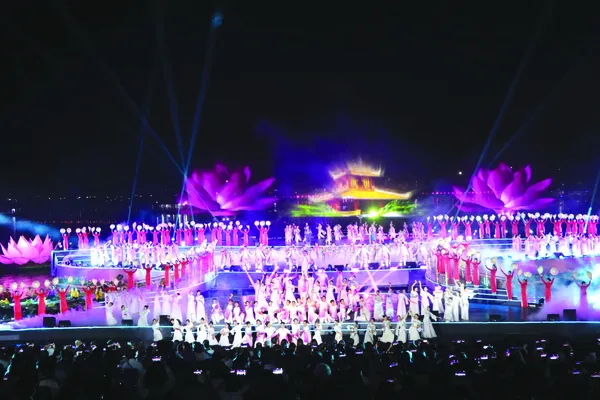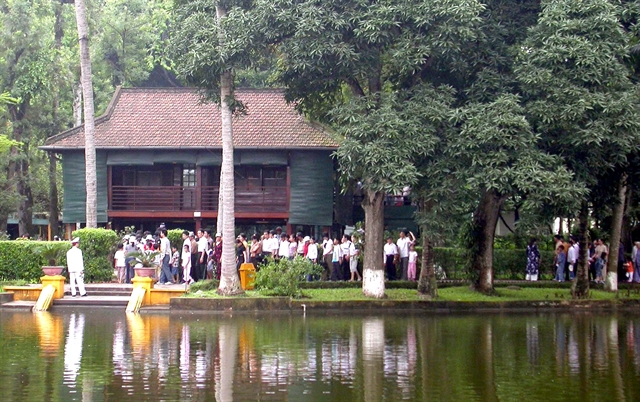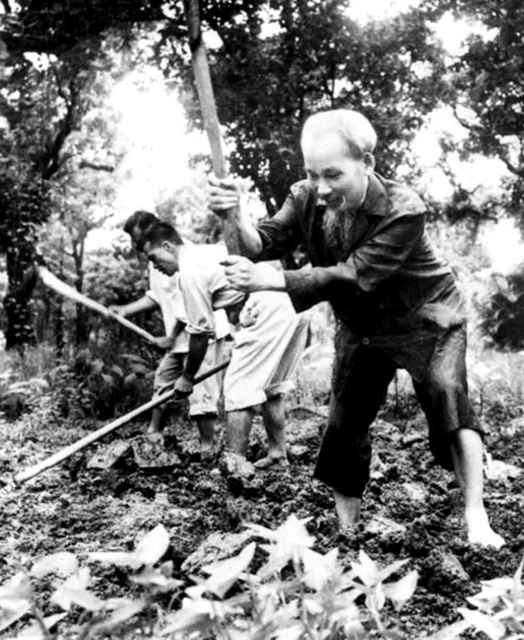 Features
Features

It would be a good idea to adopt Uncle Hồ's house on stilts as a model for a 'post-corona' world, a more modest, more sustainable, more elegant and environmentally friendly future.

|
| BEAUTY: The simple wooden house in Thai-style with a tiled roof is nestled in a lush garden by the side of a fish pond. VNS Photo Đoàn Tùng |
by George Burchett*
I visited President Hồ Chí Minh's house on stilts for the first time in December 2006.
It was also my first return to Hà Nội, where I was born a year after the historic victory at Điện Biên Phủ, and two days before Uncle Hồ's 65th birthday.

|
| HARD WORK: This archive photo taken in 1957 shows President Hồ Chí Minh, then 67, hoeing the garden in the Presidential Palace to plant vegetables. VNA/VNS File Photo |
These were my impression of that very first visit, confirmed by subsequent ones, taken from my 2009 article The Ten Principles of Bandung:
I thought this is the most beautiful house in the world. It is a modest wooden house on stilts, modelled on the traditional Montagnard hut in which Hồ Chí Minh stayed during the years of anti-French resistance (1946-1954). It is very simple, elegant, functional and energy-efficient – the only 'luxury' item was a small electric heater for Hà Nội’s winter chills. The house took less than a month to build. Uncle Hồ specifically instructed that no precious timber should be used. It faces a large pond in which several varieties of fish breed and were occasionally cooked for Uncle Hồ and his guests. It is surrounded by beautiful gardens, with palm trees, fruit trees, flowers, a great variety of native and imported plants. From here, dressed in simple peasant garb, Uncle Hồ directed the resistance against the USA and its allies. So if you want a model of sustainability, elegance, simplicity, resilience, harmony, goodness, economy, energy efficiency, greenness and beauty, you have it in Uncle Hồ’s house.
I have been living in Hà Nội since March 2011 and have been observing how Hà Nội is rapidly changing.
Some time ago, I told a friend – who is also a true Hanoian, of the heroic war-time generation – that if a genie popped out of a bottle and said to me: "George, I can take you any place at any time in history", my answer would be: "Take me to Hà Nội before motorbikes when the trams were still running."
This is a Hà Nội I only know from black and white photographs, taken by my father, Australian journalist Wilfred Burchett, when US bombs were falling on the capital of North Việt Nam. They show destruction, but also resilience, dignity and calm confidence in victory. And a kind of serene beauty.
During the recent period of COVID-19 social distancing, I re-read my father's book, Vietnam North. It explains how North Việt Nam coped with war-time conditions: the relocation of industry, medical facilities, schools and universities, ministries – almost the entire infrastructure of the country was on a war footing. The people were united in the sacred cause of defending the motherland and making the country one again. President Hồ Chí Minh's dream of Liberty and Independence was finally achieved on 30 April 1975, 20 years after Điện Biên Phủ.
Today, Việt Nam, and the rest of the world, are fighting a new enemy, a new virus, that is wrecking chaos around all over our planet. Being in Hà Nội during the period of social distancing, I couldn't help but think back to the war times, which my father reported from the jungles of South Việt Nam with the "Việt Cộng" and from Hà Nội under bombs, and always from the "Hồ Chí Minh" side. It is a heroic narrative I grew up with and which is embedded in my consciousness. I tell people: "I was born on the Hồ Chí Minh side and I'm still on the Hồ Chí Minh side." And I can proudly add: "I will always be on the Hồ Chí Minh side."
So I take great pride in the efficient and successful way Việt Nam has dealt with the pandemic. This hasn't gone unnoticed by the international community.
But something the rest of the world may not be aware of is how beautiful and peaceful Hà Nội was under social distancing. That peace and quiet fits Hà Nội so well. Instead of ridiculously loud motorbikes, construction noises and other forms of noise and other pollution, I could hear the birds, which seem to have miraculously multiplied. I discussed this with Vietnamese friends at a post-social distancing reunion and all agreed: we want coronavirus to go away, but we wish the peace and quiet would stay.
Which takes me back to Uncle Hồ's house on stilts. Perhaps it would be a good idea to adopt it as a model for a 'post-corona' world, a more modest, more sustainable, more elegant and environmentally friendly future. Why look up to French Kings, Roman Emperors and other examples and symbols of royal and imperial power and extravagance when developing the country? Why not Uncle Hồ's simple Montagnard hut?
I believe now is a very good time to ponder these issues. Uncle Hồ's house and Mother Nature are trying to tell us something. We should pay attention.
I would like to close by quoting a poem from President Hồ Chí Minh's Prison Diary:
The Weather is Clearing Up
Everything evolves, such is the law of nature.
After days of rain, here's fine weather coming!
In an instant the earth has cast off its damp clothing;
Over ten thousand li the land spreads its brocade coverture.
Under a warm sun and balmy wind flowers smile with rapture;
In the tall trees with shiny boughs birds their trills rehearse.
Joy fills man's heart as well as the universe.
After the bitter comes the sweet: so runs the course of nature.
* George Burchett is a visual artist and occasional writer. He has contributed to the recent Phúc Tân Public Art Project on the Red River in Hà Nội.




